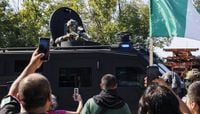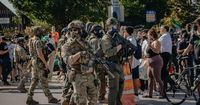On the morning of October 4, 2025, a tense standoff in Chicago’s Brighton Park neighborhood erupted into violence, marking the second time in recent weeks that federal agents have fired on a civilian in the area. The incident, which began around 10:30 a.m., unfolded as U.S. Border Patrol agents conducting immigration enforcement operations found themselves boxed in by a convoy of approximately ten vehicles. According to the Department of Homeland Security (DHS), one of the drivers, later identified as Marimar Martinez, was armed with a semi-automatic weapon and allegedly attempted to ram the agents’ vehicles.
As reported by multiple outlets, including the Chicago Sun-Times and NewsNation, Martinez was shot by Customs and Border Patrol (CBP) agents during the confrontation. Tricia McLaughlin, a spokeswoman for DHS, stated, “The patrolling agents were rammed by 10 cars and boxed in.” She added that agents fired “defensive shots” when they discovered Martinez was armed. After being struck, Martinez managed to drive herself to Mount Sinai Hospital, where she was treated for her injuries and discharged the same day. By Saturday evening, she was in FBI custody, according to DHS statements.
The shooting set off a chain reaction in the community. By noon, roughly 100 protesters had gathered along Kedzie Avenue, their chants of “ICE go home” echoing between small businesses and the nearby rail yard. The demonstration quickly escalated as federal agents deployed pepper balls and tear gas to disperse the crowd. Skirmishes continued throughout the afternoon, with several protesters detained and at least one man—identified by witnesses as a U.S. citizen—taken into custody at a nearby gas station. Alderman Julia Ramirez, who represents the 12th Ward, witnessed the escalation firsthand and later remarked, “There was pure escalation from federal agents on Saturday. It doesn’t seem like things are calming down. We’ve seen immense anger from neighbors feeling like federal agents are provoking and wanting to incite violence on people who just care about keeping people safe.”
According to DHS, the situation for agents was dire enough that several CBP officers were hospitalized with injuries. The department also reported that an ICE vehicle was mobbed and significantly damaged, forcing law enforcement to abandon it for their own safety. In addition to Martinez, Anthony Ian Santos Ruiz was apprehended at the scene, along with two other individuals—one for allegedly assaulting CBP officers and another for ramming an ICE vehicle. The department further claimed that Martinez had been named in a CBP intelligence bulletin the previous week for doxxing agents and posting threats against ICE online, though no further details have been released to the public regarding these allegations.
Chicago police, for their part, maintained a limited role in the federal operation. A spokesperson said that officers responded only to “document the incident” and “maintain safety and traffic control for all living and working in the area.” The police department emphasized that it was not involved in the incident itself or its investigation, leaving the matter squarely in the hands of federal authorities. “We’re here so that you can protest,” Deputy Chief Gabriella Shemash told demonstrators, even as frustrations mounted over the department’s perceived lack of support for the community.
As the afternoon wore on, tensions remained high. Protesters accused federal agents of intentionally provoking violence, with some witnesses reporting that undercover SUVs repeatedly drove through the crowd, further agitating demonstrators. At one point, a military-style vehicle pulled up near the protest, and an agent was seen drawing his gun and pointing it at the crowd below. “Now they got the SWAT truck here like we are like the military now, this is like a war zone here,” one protester, Gabriel, told reporters.
The unrest in Brighton Park was not an isolated event. Since the Trump administration launched “Operation Midway Blitz” in Chicago the previous month, federal immigration enforcement has been ramped up across the city and its suburbs. According to DHS, ICE and CBP officers have made over 1,000 arrests during the operation. This aggressive approach has sparked waves of protest, particularly in immigrant communities already wary of law enforcement. On October 3, just a day before the Brighton Park shooting, hundreds protested outside the ICE facility in Broadview, resulting in multiple arrests. The Cook County Sheriff’s Office confirmed that 13 people were arrested on Friday, with five additional arrests reported by other agencies.
These events have drawn sharp criticism from local and state leaders. Illinois Governor JB Pritzker has repeatedly voiced objections to the federal presence, yet the White House announced late Saturday that it would deploy 300 National Guard troops to Illinois to “restore law and order.” DHS Secretary Kristi Noem echoed this sentiment on social media, stating she was “deploying more special operations to control the scene.” Federal officials, including FBI Chicago field office head Douglas DePodesta and ICE’s Matthew Scarpino, issued a joint statement: “There is no place for violence against law enforcement officers, obstruction of justice, or destruction of federal property.”
Community members, however, told a different story. Residents like Nari, a gas station worker, described hearing gunshots and seeing ICE agents by the road. “It’s scary and it’s wrong,” said Matthew, a local resident who did not share his last name. Reina Diaz, who has lived in the neighborhood for 36 years, lamented, “It hurts, it hurts because we are all here fighting for ourselves. It’s a shame that the president is harming the economy of this country.” Others, like Maritza Vega, recounted the chaos as tear gas filled the block: “It’s a disgrace because they shouldn’t be treating people like that at all, the way they were standing out there with those big old guns [when] nobody was touching them.”
The shooting in Brighton Park comes on the heels of another deadly encounter. On September 12, 2025, federal immigration agents fatally shot Silverio Villegas González during a traffic stop in Franklin Park, a northwest suburb of Chicago. DHS initially reported that Villegas González had resisted arrest and attempted to drive into ICE officers, dragging one before being shot. However, body-worn camera footage obtained by the Chicago Sun-Times suggested that the officer’s injuries were not as severe as first described.
As federal authorities continue their aggressive enforcement campaign under Operation Midway Blitz, the divide between law enforcement and Chicago’s immigrant communities appears to be deepening. With more protests expected and the arrival of National Guard troops, the city faces an uncertain and potentially volatile future. For now, the streets of Brighton Park stand as a testament to the growing tensions at the intersection of immigration, law enforcement, and community resistance.


